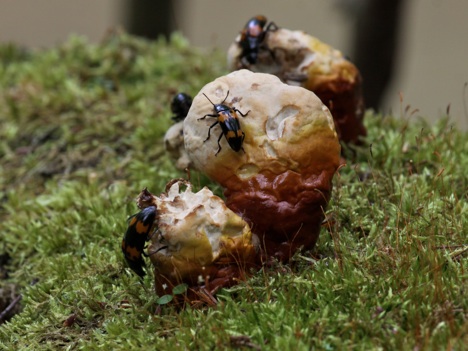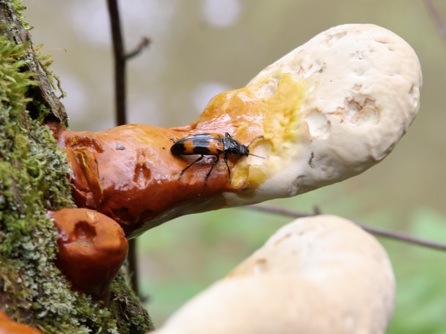The Nature
Observer’s Journal
The Nature
Observer’s Journal

Pleasing Beetle, Polished Fungus
Chuck Tague
On the recent Nature Journal adventure with the home schooled friends I found a familiar pair of associates, one a fungus and the other an insect. Although I know the pair well, I’d never before seen either at McConnell’s Mill State Park.
I first encountered the Pleasing Fungus Beetle in the old growth forest at Heart’s Content, in Warren County, PA. According to my records it was on June 8, 2002. I adapted this account from the Nature Observer’s Journal, June 2002.
I noticed a hemlock log with white bumps sticking out of the side. The bumps looked like unbaked biscuits just cut from fresh white dough. A short distance down the trail I found some more dough buttons. These were a little larger and looked like someone had poured molasses along the edges. The next hemlock had even bigger bumps, nearly the size of a baseball.
I examined one. Obviously they were emerging mushrooms but there was not yet enough shape to even speculate what kind they might be. Under the one I examined was a beautiful orange and black beetle. I put the colorful beetle in a plastic box, examined and photographed it then put the beetle back on the fungus.

It had rained heavily during the week before and the old forest was very moist. I’ve watched mushrooms under ideal conditions before and I’m always amazed at how quickly they grow. When I observe and measure garden plants I can sometimes see a noticeable difference the following day. If I carefully watch an opening flower bud I can see changes in an hour. Mushrooms seem to explode rather than grow. After a soaking rain they appear and develop in what seems like minutes.
I wondered if the dough buttons were really growing that fast or if the growing conditions were better deeper in the woods.
As I walked along the mushroom buttons changed to thick spatulas. Then they began to resemble typical bracket fungus. The shiny molasses stains also grew, covering all but the outer white edges. Finally the light bulb lit over my head. They’re one of the first fungi I learned and a common mushroom in the old forest. They’re called Hemlock Varnish Shelves. Sometimes they’re as big a dinner plate.
Hemlock Varnish Shelf, Ganoderma tsugae, is a bracket polypore. Its size and varnish-like gloss makes it both unmistakable and unforgettable. They are saprophytes, decomposers that obtain nutrients from dead hemlock wood.
An hour later I started up the other side of the forest. The fungi were larger yet and their shapes were more developed. One standing dead hemlock was circled with thick fresh conks and each one was covered with beetles. There were obvious chew marks on the mushrooms. I counted at least forty beetles. They were scurrying around, munching away and at least two pairs were mating. It was a party, a feast, a beetle bacchanal.
The beetles appeared from the forest as fast as the Varnish Shelves grew. I put one of the beetles in a box. I had to know what they were.

Back at the parking lot I got out my field guides to insects. I thumbed through the section on beetles. I looked at the first color plate I came to and there it was – the Pleasing Fungus Beetle, Megalodacne heros. I read the description. No doubt, a perfect match and a perfect name.
Monday, June 6, 2011
